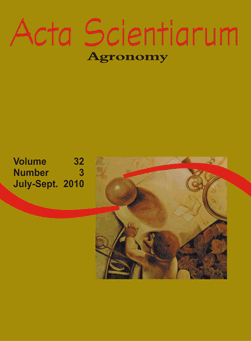<b>Meiotic behavior in <em>Panicum maximum</em> Jacq. (Poaceae: Panicoideae: Paniceae): hybrids and their genitors</b> - doi: 10.4025/actasciagron.v32i3.6461
Keywords:
breeding program, meiosis, intraspecific hybrids, Panicum maximum
Abstract
Panicum maximum Jacq. is one of the most cultivated grasses in the world. The intraspecific hybridization breeding program underway at Embrapa Beef Cattle aims at combining several agronomic characteristics in a single plant with high seed production. Four intraspecific hybrids originated from the cross between sexual tetraploid female plants with apomictic tetraploid male plants, including the genitors, were cytologically evaluated in the meiotic process throughout conventional methodology. Hybrids and genitors showed high meiotic stability. The percentage of abnormal cells among them ranged from 6.7 to 14.2%. Abnormalities recorded were irregular chromosome segregation, chromosome stickiness, and absence of the first cytokinesis, but the latter did not compromise pollen viability. Multivalent chromosome configurations at diakinesis, ranging from one to three quadrivalents, suggest that genetic recombination and introgression of some genes can be expected in the hybrids. Based on meiotic stability, the hybrids should be selected for high seed production, and the genitors could remain in the program participating in other intraspecific crosses.Downloads
Download data is not yet available.
Published
2010-08-25
How to Cite
Pessim, C., Pagliarini, M. S., Jank, L., Kaneshima, A. M. de S., & Bonato, A. B. M. (2010). <b>Meiotic behavior in <em>Panicum maximum</em> Jacq. (Poaceae: Panicoideae: Paniceae): hybrids and their genitors</b> - doi: 10.4025/actasciagron.v32i3.6461. Acta Scientiarum. Agronomy, 32(3), 417-422. https://doi.org/10.4025/actasciagron.v32i3.6461
Issue
Section
Genetics and Plant Breeding
DECLARATION OF ORIGINALITY AND COPYRIGHTS
I Declare that current article is original and has not been submitted for publication, in part or in whole, to any other national or international journal.
The copyrights belong exclusively to the authors. Published content is licensed under Creative Commons Attribution 4.0 (CC BY 4.0) guidelines, which allows sharing (copy and distribution of the material in any medium or format) and adaptation (remix, transform, and build upon the material) for any purpose, even commercially, under the terms of attribution.
2.0
2019CiteScore
60th percentile
Powered by 

2.0
2019CiteScore
60th percentile
Powered by 



















































